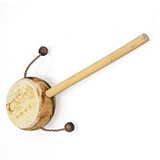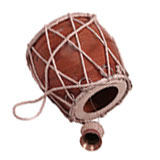A to Z of Percussion Instruments
Aboriginal Musical Instruments
From hand clapping and lap slapping to drums made from logs and reptile skins.
Agogos
Made of iron and steel, they are used in samba and its offshoots. The sound is made by striking a stick against the instrument’s two bells.
Bell(s)
Although bells are universal, their use and meanings are greatly culture specific. Made from a wide variety of natural and synthetic materials, including clay, wood, metals of all kinds, and animal hooves and there are two basic kinds: the body may be closed at one end and open at the other ("cup" bells) or it may be entirely closed and hollow, with a metal pellet inside ("crotals"). Some have clappers, or internal attachments which strike the body when the bell is shaken. Wooden bells such as the Chinese Temple Block, are often clapperless - that is, you strike them on the outside surface with a hammer or rod. Blocos sonoros
Bodhran or Frame Drum
The drum skin is stretched over a wooden hoop and it has wooden cross effect holdbars inside. The drum is usually played with a beater. The Bodhran is great fun to play and very versatile, making it an ideal choice for a complete novice or an experienced player.
Bongos
These are two small drums, one high and one low, tuned by turning metal screws in the shell. Of African origin, they are often used in reggae and salsa, along with congas.
Cajon
Known as an instrument of Flamenco Percussion, the Cajon originated from a codfish box aboard Spanish boats sailing to America in the 16th century.
Candombe
Afro-Uruguayan rhythm Candombe. Three drums of the Cuerda and more.
Castanets
Castanets have been around for more than 2000 years. There are differences between male (from Mars?) and female (from Venus?) castanets.
Congas
The conga is a tall, narrow, single-headed Cuban drum of African origin, probably derived from the Congolese Makuta drums or Sikulu drums commonly played in Mbanza Ngungu, Congo. A person who plays conga is called a "conguero". Although ultimately derived from African drums made from hollowed logs, the Cuban conga is staved, like a barrel. These drums were probably made from salvaged barrels originally.
Daiko
Daiko is a generic Japanese term for many different styles of drums of cylindrically shape that have a drum head either tacked on directly to the body or attached by ropes or cords. The tsuri-daiko, also known as a "hanging drum", is a shallow, round instrument often suspended in a circular wooden or metal frame with an upright stand. Performers strike the drum with short, padded wooden mallets. The right mallet is called obachi , or male stick, and the left, mebachi , or female stick.
Darabukka
Arabic instrument, very popular throughout the Middle East and other Islamic-influenced countries. It's also known as a dumbek, derbocka, and dumbelek.
Deerskin Drum
This is a hand drum of the natives on the West Coast of Canada.
Djembe
This instrument is by far the most popular African drum to be played outside of Africa.
Double Bell
For those who believe two bells are better than one.
Dulcimer
This stringed instrument was the forerunner of the piano, which is also considered a percussion instrument.
Ganzás
A long shaker with little shells, beads, or seeds inside. Also known as “xique-xique” because of the sound it makes. Used a lot in samba and bossa nova.
Jaw's Harp (also called a Jew's Harp)
Found throughout much of the world from New Guinea to Spain, the Jaws' Harp is not a harp at all and it has no historic association with Jewish traditions. Its name might be a mistranslation of a French word, 'jouer', which means 'to play'. In 15th and 16th century Britain, this instrument was called a 'Jew's Trump'; in 19th century Italy, 'scacciapensieri'; loosely translated, this means "to chase your thoughts or troubles away". In contemporary Spain it is called the 'trompa inglesa', which suggests that it was imported (though not necessarily from Britain.) The instrument is popular because it is portable and relatively easy to play.
Karate Drums
The Japanese drum group Ryukyukoku Matsuri Daiko.
Kettle Drum
Use of the Kettle Drum, ancestor to our modern Tympani, dates back to before 4000 B.C. They have also played a significant role in European music since the 13th century. First brought to the west by soldiers during the Crusades, kettle drums were traditionally associated with with military bands and campaigns. These and other instruments were used to mark time, to signal attack and strike fear in one's opponents.
Khomok
The khomok of the Baul people of Bengal is also known as a khamak, anandalahari, and gubgubi.
Klonton
Similar to the Karate Drum, this instrument has pebbles inside.
Lambeg Drum Tradition
The Lambeg drum of Ireland, also known as, "a bodhran on steroids!".
Lithophone
The name “Lithophone” is composed of two words: lithos=stone & phone=sound. A lithophone therefore, is a musical instrument consisting of a collection of rocks or pieces of rock, in which musical notes are sounded by striking one or more of the rocks in combination. Surprisingly there are a large number of them around the world in places as far apart as China, Iceland, Togo and Venezuela. The Chinese ch’ing is a set of 16 L-shaped tuned stone slabs suspended in a large frame which are struck on their long side with wooden mallets or padded sticks.
Maracas
These shakers look easy, but you have to have a certain technique to be able to accompany music with them. They are made of gourds, coconut shells or metal, with handles. In Brazil they are used in regional dances like Bumba-meu-boi and others. They are also used a lot in Caribbean music and in rhythms like bolero, mambo, cha cha, etc.
Marimba
Percussion instrument of African and Latin American origin. A regional term for the African mbira. Like the Xylophone but a lot softer and warmer sounding.
Mbira
The mbira of the Zezuru group of the Shona people of Zimbabwe consists of 22 to 28 metal keys mounted on a gwariva (hardwood soundboard) made from the mubvamaropa tree (Pterocarpus angolensis). Although the metal keys were originally smelted directly from rock containing iron ore, now they may be made from sofa springs, bicycle spokes, car seat springs, and other recycled steel materials. The mbira is usually placed inside a large calabash resonator (deze) to amplify it. A mutsigo (stick) is used to wedge the mbira securely inside the deze. The mbira is played with the two thumbs stroking down and the right forefinger stroking up. Either metal beads strung on a wire, or bottle tops or shells mounted on a metal plate, are placed on the lower portion of the mbira soundboard to add a buzz which varies from a soft hiss to a tambourine-like sound. Bottle tops or shells are also mounted on the mbiradeze to increase the buzz. The buzz is considered an essential part of the mbira sound, required to clear the mind of thoughts and worries so that the mbira music can fill the consciousness of the performers and listeners. The buzz adds depth and context to the clear tones of the mbira keys, and may be heard as whispering voices, singing, tapping, knocking, wind or rain.
Moringas
A small ceramic jar with a hole in the middle. Played with two hands, one producing a high sound and the other low. To produce a high sound you strike the side of the jar, and for a low sound, you strike over the hole, damping and releasing the air.
Pandeiro
Originally from East Africa, the pandeiro (tambourine) is considered the complete percussion instrument because it has low, medium, and high timbres. Made of wood, goatskin, and five sets of jingles, the conventional pandeiro from Rio de Janerio was introduced into samba and chorinho as a rhythmic base. Later it spread all over Brazil in different ways, and rhythms. It is played in folkloric, pop, and erudite music, among other styles.
Reco-reco
Of African origin, the reco-reco is made of bamboo or iron. The sound is produced by rubbing a rod on its ends and grooves. Used a lot in traditional samba (“roots” samba) and reggae.
Repiniques
Created by samba schools to make a high, piercing sound. It is also used as a calling (lead) and solo instrument in the samba school bateria (percussion band). In samba it is played with a stick in the right hand, with the left hand beating counterpoint directly on the drum head, or vice-versa. It is played together with the tamborins in a galloping rhythm.
Shekere
Don't let the name throw you - it's just a rattle!
Steel Drum / Pan
The islanders of Trinidad and Tobago first created these steel drums (or pans) in the 1930's, from empty 55-gallon oil barrels.
Surdos
With their deep sound, surdos are used to mark time and rhythm. There are three kinds of surdos: first, second, and cutting (or third). The surdo is the heart of the samba school baterias, but is also used in frevo, samba reggae and axé music.
Tabla
Percussion instrument from North India.
Tam Tam
Played with one hand on the head and the other on the shell of the drum. Sometimes it’s used to keep time, and others to play variations.
Taiko
The Drum (Taiko in Japanese) was the first instrument used by mankind.
Talking Drum
"Gan Gan" and "Dun Dun" could have been the first words you uttered as a baby, but... they're also West African names for small and large Talking Drums.
Timbas
From the same family as the Tan tan and the Rebolô, the Timba, used a lot in samba, has a low sound that marks double time with one hand on the head and the other playing counterpoint on the shell.
Tambour
French Drums, anyone? Here's one that was popular a few centuries ago in western European regimental and marching bands.
Tambourine
Gypsies weren't the first to use these ancient instruments and even Mozart jumped on the bandwagon.
Teponaztli
If you're into the Ancient Aztec Gods, you won't want to miss this instrument.
Tongue Drum
The tongue drum is of Aztec origin. Also called log drum or tone drum. The slit drum is a similar log drum of African origin. Traditionally made from a hollowed log -- the modern version is a wooden box with tongues cut into the top, played with mallets.
Tortoise Rattle
This is a traditional instrument of the Ojibway people of Central Canada, used in ceremonies.
Udu
This is a vessel drum originating from the Igbo people Nigeria. First used as a clay pot for carrying water, it was only played as a musical instrument by the women of the village. But today, it is the udu's various acoustical tones and temperament that is what modern musicians have come to love. These ceramic pot drums are so pretty, in fact, that they make wonderful decorations when you're not playing them!
Xylophone
The xylophone is made of bits of wood that are tuned to different notes. The player uses sticks, or beaters, to hit the wooden bars, sometimes as many as six at a time!













































